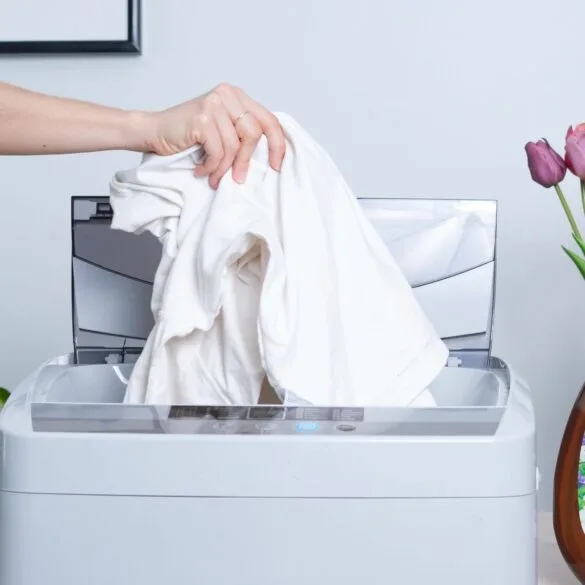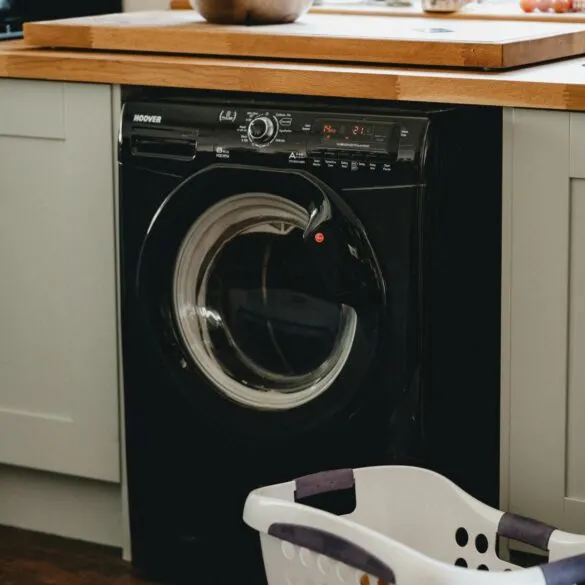When was the last time you cleaned your washing machine? The very first washing machine I owned was a top load washer, and I think I cleaned it once in seven years. So you’re probably doing better than me! But now that I know better, I take better care of my washing machine and actually clean it.
It is important to regularly clean your washing machine, especially if you have a front load washer. In this article I’ll walk you through how often you should be cleaning your machine and a couple different techniques to get the job done.
Regularly Cleaning Your Washing Machine
Washing machines are often taken for granted, even though they are one of the most used appliances in our homes. Mine seems to be running constantly.
Show your washing machine some love by taking the time to regularly clean it. This will help keep your washing machine running well, and reduce the risks of breakdowns or bigger issues.
Regular cleanings are even more important for front load washing machines because their seals seem to be more prone to mildew and mold.

How to Know When It’s Time to Clean Your Washing Machine
If you don’t regularly clean your washing machine, it can become a breeding ground for bacteria.
It’s easy for hair, lint, minerals from your water, and residue from laundry soaps and detergents to clog up parts of the washing machine.
When this happens you might notice that your clothes aren’t getting as clean as they used to. There might also be a mildewy or moldy smell to your washing machine tub or your laundry room.

How Often Should I Clean My Washing Machine?
It’s recommended that you run your washing machine through its cleaning cycle once a week, and hand washing the basin once a month.
If it’s been longer than 6 months since you last cleaned your machine, it’s definitely time to clean it now.
How to Clean Your Washing Machine
The best way that I’ve found to clean my washing machine is to use a cleaning wipe, like clorox wipes. I first wipe down the basin and then do my best to wipe the seals around the door.
After wiping everything down, it’s time to run it through a cleaning cycle. There are a few different things you can choose to add to your machine for its cleaning cycle. The two most common options are bleach or vinegar. Although you would NOT want to add them together at the same time.
Sometimes this will remove all the gunk and build up, but other times I need to do a deeper clean.
Deep Cleaning Your Washing Machine
If you haven’t cleaned your washing machine for a while, you may have so much buildup behind the door seal, that just running a cleaning cycle is not going to touch it.
When this happens, I recommend doing a deep clean on your washing machine seals. You’ll need to purchase or find a sponge paintbrush. (You can use the two inch or four inch paint brushes.) Then dip the sponge paintbrush in a little bit of bleach. Carefully pull back on the seals and run the paint brush between the seals and the basin. This will clean out any of that hard to reach mold or mildew that builds up between the seals.
For front load washing machines, if you look at the bottom seal you should be able to see the opening of the water drains. These will sometimes get clogged if you haven’t cleaned your washing machine for a while. If these drain openings are really clogged the water in your washing machine won’t drain all the way.
The best way to clean these drains is with an old baby medicine dosing syringe. Fill the syringe with a small amount of bleach and push it into the drain to clear away the debris. If the drains are really clogged, you might also have to gently use a toothpick to loosen up and clear the gunk.

How to Clean Your Washing Machine’s Drain Pump
For front load washing machines you also need to be cleaning your washing machine’s drain pump every six months.
- Locate and Open your Washer’s Filter Door. The filter door is a small, rectangular door on the bottom right-hand corner of your machine. Some doors have a push and release button. For other access doors, you might need a flathead screwdriver to wedge it open.
- Unhook the emergency drain hose. You should see two things behind the filter access door: a round dial and a rubber hose. Unhook the hose from the clip holding it in place. You’ll want to have a bucket and a towel on hand because the hose will drip when you remove the cap.
- Empty the hose. Hold the drain hose over your bucket and remove the cap.
- Remove the drain pump filter. The filter is the round dial. Rotate it (usually counterclockwise) until you can remove the filter from your washing machine.
- Clean the drain pump filter. Grab the filter with your towel and get to a sink. Rinse away any accumulated debris or gunk and wipe your filter with the towel. You might be surprised at what you find! Often there are coins and sometimes rings. You might want to wipe down the washer’s drain pump compartment too.
- Replace the drain pump. Now that your filter is clean, put the drain pump filter back and turn it (clockwise) to lock it into place. Replace the cap on the emergency drain hose and secure the hose back inside the washer. Close the access door, and now your washing machine is ready to go.
Remember to always check your pockets before doing laundry. Change and other small objects can find their way into the drain pump, and will decrease the lifespan of your machine.
Clean Your Washing Machine Before Going On Vacation
Another tip to keep your machine free of bacteria, is to clean it right before going on vacation. Bacteria has more of a difficult time growing when the machine is being used each day. But when your machine sits for a few days, the bacteria can quickly grow and multiply.
You don’t want to come home from vacation to a gross smell and a mildewy washing machine. Especially since you’ll have tons of laundry to do when you get back.
So remember to give your washing machine a quick clean before you leave your home.
